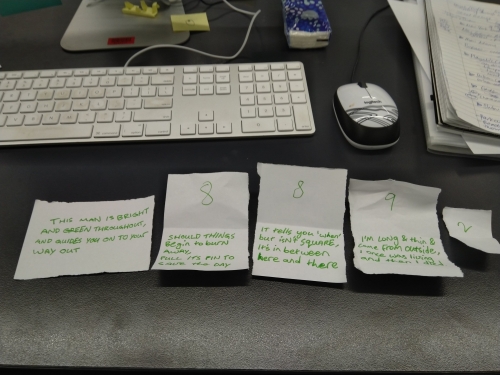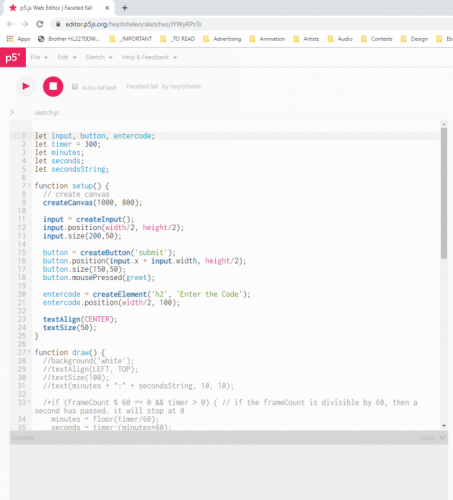***This project was made in collaboration with Helen Kwok.***
Theme: Play & Place
Context:
During the presentation portion of the class I was particularly struck by the sections relating to childhood and street games, and really wanted to tap into that to make something collaborative and fun that would transform a space. Speaking to Helen we both realised we had similar ideas and decided to join forces to make something fun! We wanted to take this opportunity to transform the MAGI studio into a playful environment - a "magic circle", or a special place in time and space created by our game (Salen & Zimmerman 2004).
For this game, we were influenced by a lot of childhood games such as scavenger hunts and riddles. As riddle solving can sometimes be a daunting process when done alone, so we thought having teams of two would allow for teamwork and collaboration, where team players can work together to solve puzzles. This was hugely inspired by cooperative play in games like escape rooms, The Amazing Race and Keep Talking and Nobody Explodes.
Costello and Edmonds’s A Study in Play, Pleasure and Interaction Design (2007) informed a lot of our considerations for how we would design our scavenger game. From their framework of thirteen pleasure categories we wanted to explore discovery, which is described as the pleasure participants get from making a discovery or working something out. We wanted to explore this from our implementation of riddles. We also wanted to explore the categories of competition and danger by including the goal of defusing the bomb, putting time-pressure on the participants to solve the riddles quickly and make the game more exciting.
Method:
We will create a scavenger-hunt-style, pervasive game in the MAGI studio, where the players will need to answer riddles to find codes that will defuse an imaginary bomb. The bomb interface includes a countdown timer and a codebreaker interface created using p5.js on the computer.
Response:
Our first step was deciding on which four objects in the MAGI studio we could use to form our riddles. With the help of a rhyming dictionary and looking at other riddle examples online, we came up with the following four objects and their corresponding riddles:
-
Clue #1 - Exit Sign
This man is bright and green throughout,
and guides you on to your way out. -
Clue #2 - Fire Extinguisher
Should things begin to burn away,
Pull its pin to save the day. -
Clue #3 - Red Clock
It tells you ‘when’ but isn’t square,
It’s in between here and there. -
Clue #4 - Stick
I’m long and thin, and come from outside,
I once was living and then I died.
We then attached a number to each riddle - when all the riddles are solved, the four numbers put together will form a code that will stop the bomb. While Emmett was writing out the riddles and secretly placing them on the objects, Helen jumped into p5js.org to create the 'bomb' interface - a simple input field that allowed players to input the secret code, and a submit button that tested for success and fail states. Helen then tried to add a timer to the interface, but it ended up breaking the game; as we were pressed for time, we decided to just load a timer in a separate window instead.
Check out the 'bomb' interface online: https://editor.p5js.org/heyitshelen/present/IYWyRPsTs (code to stop bomb: 8892). It's still very bare bones at the moment (definitely could look better!), but it was quick and functional for our first iteration of playtesting. We also considered adding another riddle at the very end that will help the player defuse the bomb by letting them know which "coloured wire" to cut instead of going with a four digit code, however we felt that the four digit code would be quicker to prototype and fit the theme of the ticking time bomb better.
We had three playtests of our game: first, with Ben and Rui at a time limit of five minutes. They completed the game with two and a half minutes to spare, so we lowered the timer down to three minutes for our next playtest team: Chris and Adrian. They finished it with a minute to spare! For our third playtest, we had Chen and Sahaj and lowered our timer to two and a half minutes. They finished it with about fifteen seconds to spare. Each group gave some great feedback on where to take the game next.
Video Music Credits: Action Time by Biz Baz Studio from the YouTube Audio Library
Reflection:
I had such a great time collaborating with Helen for the first time. We were both able to bring unique skillsets that made for a much stronger response. I really enjoyed the aspect of coming up with riddles and tweaking them to make them stronger or more cryptic, and Helen was able to throw together a fantastic interface for the bomb! We realised that it was a fitting response in that we as a team of two worked together to make a game where teams of two had to work together to complete it! We recognised that during each playthrough one player would figure out one half of the clues, and the other player would figure out the other half.
It was also fun to transform the MAGI studio into a playful place, utilising objects we see everyday and giving them a new meaning by incorporating them into the gameplay. The MAGI studio is a space we work in everyday; yet, how much attention do we really give to the environment around us? Do we really take note of the exit sign or the fire extinguisher?
Here are some suggestions from our playtesters on how to improve the game, as well as our reflections afterwards:
- Make the clues harder to solve. Seems like the players didn't have much difficulty solving them (although by reducing the time limit on each playthrough helped with upping the tension).
- Include sound/music into the game interface to add to the tension and drama. Maybe we can hear the bomb ticking away, or some dramatic music when the timer is about to reach zero.
- If we had more time, we would love to design the bomb interface and make it more visual - e.g. including coloured wires, or incorporating the Makey Makey with the wires themselves that trigger the bomb.
- Perhaps add a random component to the code itself, to add a a bit of variation to the game?
- Chris suggested adding an unexpected riddle at the very end (maybe after the code is entered), so players thought they've solved it, but in fact there was still one more step! We could incorporate this idea with the coloured wires. Maybe having something like four coloured wires and the final riddle being “Cut ANY wire except NOT the blue wire!”, for the added stress.
References:
Salen, K & Zimmerman, E 2004, Rules of Play: Game Design Fundamentals, MIT Press, London.
Costello, B & Edmonds, E 2007, 'A study in play, pleasure and interaction design', proceedings of the 2007 International Conference on Designing Pleasurable Products and Interfaces, pp. 76-91.
About This Work
By Emmett Redding
Email Emmett Redding
Published On: 18/08/2019
academic:
mediums:
interactive, live action, physical, programmatic, spatial
scopes:
tags:
APD, APD Week 4, APDW04, p5

